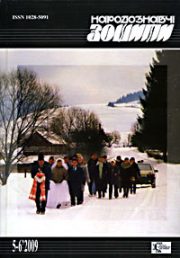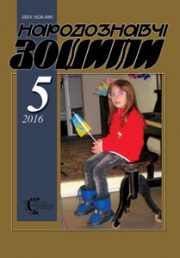The Ethnology Notebooks. 2020. № 5 (155), 1108—1127
UDK 738(477.83)”18/19″
DOI https://doi.org/10.15407/nz2020.05.1108
IVASHKIV Halyna
- Candidate of Sciences in Art Studies,
- Senior Researcher
- Museum of Ethnography and Crafts
- Institute of Ethnology
- National Academy of Sciences of Ukraine,
- 15, Svobody Avenue, 79000, Lviv, Ukraine,
- Contacts: e-mail halia_503@ukr.net
Abstract. The development of pottery in Stara Sil and Stara Ropa in Stary Sambir district, like in the entire Ukraine, had its peak in the late 19th and early 20th cc., which actually accounts for revealed deposits of high-quality clay. In general, by the end of the 1930-ies there was a large number of potters in these ceramic centres, whereas in the early 1960-ies only some of them left (predominantly potters making toys). In the second half of the 20th c. merely a few workshops were functioning at collective enterprises of the district.
The topicality of the subject lies in the fact that pottery in Stary Sambir district has not been explored in a separate study yet. The aim of the given research is to highlight the specificity of this craft in this part of Boykivshchyna in the context of its regional development. In particular, we mean the processes of digging clay, conditions of earthenware burning, the geography of spreading and trade of earthenware items as well as paying for them, etc. Moreover, it proves important to verify potters’ names on the basis of archive and expedition materials. The object of the research is pottery in Stary Sambir district, while its subject is peculiarities of the craft, relationships between potters, earthenware trade and traditions of the guild. Methodologically, the paper is based on the principles of systematicity, historism and comparativism as well as culture and historical, comparative and typological methods.
On the basis of archive materials, we have managed to examine some pages of certain potters’ biographies, their everyday life, the activity of a pottery guild in Stara Sil, its holidays and traditions. It seemed rather important to determine on what conditions the goods were sold, when the busiest trade was, namely church holidays and fairs, how much they cost etc.
Potters in Staryy Sambir district mainly dug clay in autumn, less frequently in winter. Thus, in Stara Sil the clay was taken near the hill «Bziany» («Bzhiany» or «Bzhany»), on the field called «Mordovnya», on their own land plots or Buchiv wood (otherwise referred to as «Potters’» wood).
In 1998, respondents singled out the following potters from Stara Sil and Stara Ropa: (?) Karabin; Josip Trupkevych (18th c.); Volodymyr Staromieyskyy (1854 — early 1940-ies) who ran the pottery guild and his wife Anelia Staromieyska (1884—1967); Ivan Karpinsky (18th c.); Anton Karpinsky (1865—1947) and his sons: Ivan Karpinsky (1909—1947 (?)), Mykhaylo Karpinsky (1913—1993) and cousin Anton Karpinsky; the family of Predlievychi — Bronislava, Maria (1865—1940; married name — Sydorevych) and Balbina (Varvara; 1898—1973; married name — Stoyalivska); Yevstakhiy Sydorevych; Maria Kachalub (1896—?); Mykola Likun (1890 — early 1960-ies); Ivan Suslovych (1863—1933); Mykola Suslovych (1904—1979); Franko Khmelyovsky; Mykhaylo Khmelyovsky (1903—1952). Moreover, we have discovered more than ninety surnames of potters in parish registers.
Keywords: pottery, Stary Sambir district, potters, geography of spreading and earthenware trade, holidays, traditions.
Received 26.06.2020
REFERENCES
- Kobilnyk, V. (1936). Signs on the bottoms of vessels from Knights’ times found in Stupnytsia (Sambir povit). Boykivshchyna annals (Part 8, pp. 1—12). Sambir [in Ukrainian].
- Strzetelska-Grynbergowa, Z. (1899). Old town. Lands and people. Lwow: Nakіadem muzeum imenia Dzieduszyckich [in Polish].
- Franko, I. (1982). Ethnographic expedition to Boykivshchyna. In Franko I. Complete works: in 50 vol. Literary and critical works (1905—1906) (Vol. 36, pp. 68—99). Kyiv [in Ukrainian].
- Stara Sol. (1929). The Polish address book (P. 787). Warszawa [in Polish].
- Maksymchuk, I. (1935). Household and kitchen crockery in Staryy Sambir. Boykivshchyna annals (Pp. 28—32). Sambir [in Ukrainian].
- Vahylevych, І. (1978, october). The Boyky, Rus and Slavonic people in Halychyna, 12, 117—130 [in Ukrainian].
- Kuczera, A. (1937). Sambir district. An illustrated monograph of the city of Sambir and its economy (Vol. II). Sambir: Nakladem ksegarni nauczycielskiej w Samborze [in Polish].
- Costres, D. (1939). The city of Stara Sil. Stara Sуl [in Polish].
- Mateyko, K.І. (1954). To the history of Ukrainian folk pottery. Materialy z etnografiyi ta khudozhnyoho promyslu (Pp. 16—31). Kyiv: Vydavnytstvo Akademiyi nauk Ukrayinskoyi RSR [in Ukrainian].
- Mateyko, K.І. (1956). Ukrainian folk ceramics. The directory of funds of the State Museum of Ethnography and Crafts at the Academy of Sciences of the URSR (Issue І, pp. 23—46). Kyiv: Vydavnytstvo Akademiyi nauk Ukrayinskoyi RSR [in Ukrainian].
- Mateyko, K.І. (1959). Folk earthenware of the western regions of the Ukrainian RSR in the 19th—20th cc. A historical and ethnographical study. Kyiv: Naukova dumka [in Ukrainian].
- Mateyko, K.І. (1983). Pottery. Boykivshchyna. A historical and ethnographical study (Pp. 127—128). Kyiv: Naukova dumka [in Ukrainian].
- Hurhula, I. (1966). Folk art of the western regions of Ukraine (P. 67). Kyiv: Mystetstvo [in Ukrainian].
- Stara Sil. (1968). The history of cities and villages of the Ukrainian RSR: in 26 vol. Lviv region. Kyiv: Holovna redaktsiya Ukrayinskoyi radyanskoyi entsyklopediyi AN URSR [in Ukrainian].
- [О. B.]. (1973). Stara Sil. Boykivshchyna annals (Pp. 31—38). [b. m] [in Ukrainian].
- Lashchuk, Yu. (1989). The art of Boyko earthenware. Narodna tvorchist ta etnografiya, 1, 36—40 [in Ukrainian].
- Lyalka, Ya.S., & Romanyuk, P.M. (2002). Stara Sil. The annals of undefeated Ukraine (Book 3). Lviv: Kamenyar [in Ukrainian].
- Herus, L. (2004). Ukrainian folk toys (Pp. 183—200). Lviv: Instytut narodoznavstva NAN Ukrayiny [in Ukrainian].
- Pavlyuk, S, & Chmelyk, R. (2005). The treasures of the Museum of Ethnography and Crafts at the Ethnology Institute of the Academy of Sciences of Ukraine (P. 94). Lviv: Instytut narodoznavstva NAN Ukrayiny [in Ukrainian].
- Ukrainian folk toys: a catalogue. (2006)(Pp. 7, 12). Kyiv: Vydavnychyy dim «Stylos» [in Ukrainian].
- Ivashkiv, H. (2001). Pottery. Staryy Sambir district (P. 65). Staryy Sambir: Prykarpatska asotsiatsiya rozvytku krayu [in Ukrainian].
- Ivashkiv, H. (2007). The decor of Ukrainian folk ceramics of the 16th — first half of the 20th cc. Lviv:Instytut narodoznavstva NAN Ukrayiny [in Ukrainian].
- Ivashkiv, H. (2010). Petro Linynsky’s collection of earthenware. Lviv: Instytut narodoznavstva NAN Ukrayiny [in Ukrainian].
- Ivashkiv, H. (2015). Tectonics and decor of the earthenware from Stara Sil (Boykivshchyna). Lemkowie, Boykowie, Rusini — historia, wspolczesnosc, kultura materialna і duchowa (Vol. V, pp. 547—558). Slupsk; Zielona Gora; Svidnik [in Ukrainian].
- Stary Sambir. (2000). Encyclopedia of Ukrainian studies (republished in Ukraine). Lviv (Book 8, p. 3027) [in Ukrainian].
- Stary Sambir. (1968). The history of cities and villages of the Ukrainian RSR: Lviv region (P. 758). Kyiv.
- On confirmation of privileges for the city of Stara Sil (CSHA, Lviv. Fund 146. List of files 88. File 477. P. 34) [in Ukrainian].
- Setsynsky, Ye. (1904). Materials on the history of guilds in Podillya. Papers of Podillya church-historical and archaeological society (Issue 10, p. 424) [in Russian].
- The book of session proceedings of acceptance and «release» of potters’ guild. Lviv. 1685—1793 рр. (CSHA, Lviv. Fund 52. List of files 2. File 977. P. 150) [in Ukrainian].
- The Parish book of the city of Stara Sil. 1782—1810. (CSHA, Lviv. Fund 201. List of files 4 а. File 5331. P. 22) [in Ukrainian].
- The Parish book of the city of Stara Sil. 1810—1835. (CSHA, Lviv. Fund 201. List of files 4 а. File 5332. P. 69) [in Ukrainian].
- The Parish book of the city of Stara Sil. 1843—1879. (CSHA, Lviv. Fund 201. List of files 4 а. File 5335. P. 57 а) [in Ukrainian].






